There’s nothing like slipping on a fresh pair of sunglasses at the start of the summer. While a good pair of shades is fine for the pool, they’re crucial for trail rides where we need to protect our eyes not just the sun but also dust, wind, and tree branches. Oh, and being able to see trail obstacles clearly is nice too.
What makes a great pair of mountain bike sunglasses? Fit is one of the first features people look for when selecting sunglasses. A fit that matches your face shape and more importantly, is compatible with your helmet, is key when considering the perfect pair of glasses. Optical clarity is another important feature. Can you actually see the trail and changes in terrain when you ride as sweat builds up and light conditions change? Hopefully, otherwise there’s no point in wearing sunglasses. One feature that may go overlooked is style. Let’s be honest, there’s a certain amount of vanity involved in sunglasses selection. You need a style that is compatible with your heart; something that makes you excited to wear sunglasses and something that gives off the correct “vibe” for your adventures. Vibe check!
All of the eyewear we tested is designed with active performance in mind, though some look more performance-oriented than others. We tested shield-style performance cycling glasses as well as a handful of lifestyle mountain bike sunglasses to see which ones fit our faces and riding styles the best. In the style column below, the lifestyle label denotes sunglasses with a more casual look. Let’s begin with the sportier performance sunglasses that we like for mountain biking.
| MTB Sunglasses | Style | Lens | Price |
|---|---|---|---|
| 100% Eastcraft | Performance | Both one-piece shield and dual lens, bonus clear lens | $195+ |
| 100% Hypercraft | Performance | One-piece shield, bonus clear lens | $155 |
| Adidas Dunamis | Performance | One-piece shield | $210 |
| Bollé Brecken | Lifestyle | Dual lens | $90+ |
| Bollé Chronoshield Volt+ | Performance | One-piece lens, polarized or photochromic lens | $170+ |
| Dragon Ridge X LL | Performance | Dual lens, interchangeable | $245 |
| Glade Roost | Performance | One-piece lens, polarized or photochromic lens | $109 |
| Glade Townie | Lifestyle | Dual lens, polarized | $69 |
| Journey Optics Aliso | Performance | Dual lens, high contrast, and bonus clear lens | $119 |
| Journey Optics Bommer | Performance | Dual lens, high contrast, and bonus clear lens | $125 |
| Journey Optics Pismo | Lifestyle | Dual lens, high contrast | $95 |
| Julbo Edge | Performance | REACTIV photochromatic lens | $260 |
| KOO California | Lifestyle | Dual lens, polarized and non-polarized | $150 |
| Nathan Sunrise | Lifestyle | Dual lens, polarized | $60 |
| Ombraz Teton | Lifestyle | Dual lens, polarized and non-polarized | $145+ |
| POC Crave | Performance | One-piece lens | $265 |
| POC Devour | Performance | One-piece lens, bonus clear lens | $250 |
| Roka Halsey | Lifestyle | Dual lens, polarized, customizable | $180 |
| Roka Lola 2.0 | Lifestyle | Colorful frames and good fit for smaller faces | $220 |
| Roka SR-1x | Performance | One-piece shield, high contrast | $210 |
| Roka TL-1 | Performance | Dual lens, mirrored, with anti-reflectance | $210 |
| Rudy Project Spinshield | Performance | One-piece lens, photochromic available | $164.99+ |
| Scott Pro Shield | Performance | One-piece lens | $109.99 |
| Shimano Ridescape Pulsar CE-PLSR3 | Performance | One-piece lens, interchangeable, with bonus clear lens | $90 |
| Smith Bobcat | Performance | One-piece lens, bonus clear lens | $209+ |
| Smith Momentum | Performance | Lightweight, quasi-goggle | $230 |
| Smith Shift Split Mag | Performance | Easy lens swaps, ChromaPop lenses | $289 |
| Sunski Topeka | Lifestyle | Dual lens, polarized | $68 |
| Sweet Protection Ronin | Performance | One-piece, polarized | $200 |
| Tifosi Moab Lite | Performance | One-piece interchangeable. Ships with three lenses | $80 |
| Tifosi Rail XC | Performance | One-piece | $80 |
| Tifosi Vogel XC | Performance | Dual lens | $40 |
| Tifosi Sledge | Performance | One-piece lens, three interchangeable lenses or photochromic | $79.95 |
| Tifosi Swank | Lifestyle | Dual lens, polarized and non-polarized, customizable | $25+ |
| Tifosi Swick | Lifestyle | Prescription option available | $100 |
Mountain Bike Performance Sunglasses

100% Eastcraft
- Price: $195 – $225
- Available at Amazon
- Tester: Matt Miller
The 100% Eastcraft’s signature cyclops-style shield lens spans your face, but you can swap in two clear lenses that clip into an open wind-channel above the nose bridge. At first glance, the clamp tool and multi-page pamphlet felt overengineered, and the packaging—big enough to rival Beats or Apple—was just as excessive.
Once I tossed the box and foam, these became my new favorite MTB sunnies. They’re light, comfortable, and “barely there,” and you can swap lenses with a fingernail (no tool required) in under a minute. The clear lenses aren’t a single piece like the shield, but it hardly matters. With aggressive styling and a premium price tag, the fit and feel still make them worth it.


100% Hypercraft
- MSRP $155
- Available at Amazon and other retailers
Personally, after riding single-piece lenses over the past couple of years, I like them more than two separate lenses. Usually, there is a larger field of vision, they cover more of your peripheral, and still allow the rider to have a decent peripheral vision without obstruction.
The 100% Hypercraft sunglasses fit this description to a tee. They have a wide, unobstructed and well covered field of view. They are also exceptionally light, comfortable, and vented. The looks however, will be divisive for some. I didn’t mind the appearance, especially given their performance, but they’re on the racy end of mtb sunglasses.
The Hypercrafts come with an extra set of clear lenses, and they are very simple to change. Just pop the temple off the corner of the lens, and snap it into place on the other lens. Although $155 isn’t cheap, it feels like a solid value for the Hypercraft. They are a killer pair of glasses for riding in any conditions. The darker lenses aren’t too dark for deep in the woods, and they are easy to convert on the trail to the clear lenses.
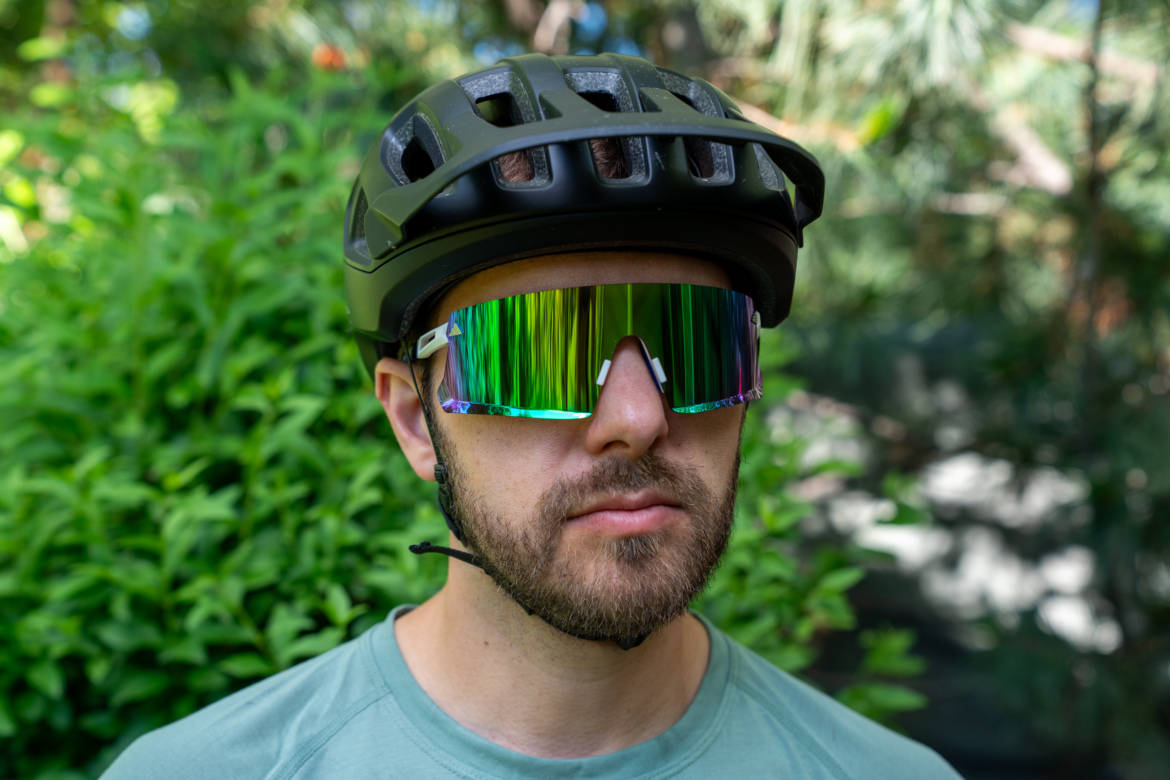
Adidas Dunamis
- MSRP: $210
- Weight: 27g
- Tester: Greg Heil
The Adidas Dunamis is unapologetically designed for performance. The unique lens shape is crafted with a proprietary Marcolin mold. The lens features an “aerodynamic spoiler” on the bottom, which Adidas says provides “the best air cut during performance.” The glasses also feature hefty rubber grippers along the temples and adjustable nose pads.
On the trail, I found the Dunamis lens to provide the most coverage of any lens tested during the 2025 field test. Indeed, it’s almost impossible to look beneath or around the lenses at all. The wrap-around and side protection is unparalleled, so if you ever struggle with getting mud or dust in your eyes, the Dunamis could be the answer.
While the arms initially felt wispy-light and insubstantial, I found the rubber grippers on the arms paired with the nosepads to provide a rock-solid fit, even on rough, extended downhills. The combination of massive lens coverage, light weight, and zero movement in the field makes the Dunamis a winner — as long as you can handle the aesthetic of the spoiler.
Bollé Chronoshield Volt+ Polarized Sunglasses
- Price: $170 – $260
- Available at Bolle
- Tester: Chris Scheiffer
Bollé has brought back one of its most iconic eyewear shapes: the Chronoshield. First launched in 1986 with neon hues and an oversized lens inspired by the Chrono ski goggles, the new version still packs that retro punch. When I opened the hilariously large protective case, I laughed—these look like strapless ski goggles. They’re a unique statement, though definitely overwhelming on petite faces like mine.
The standout feature is the Volt+ Polarized Lens, which Bollé says reveals colors you’ve never seen while keeping a natural white point. It boasts enhanced depth perception, high-performance polarization, 16% light transmission, and a proprietary anti-fog coating with vents that clear moisture in seconds. Quite frankly, the lens is the show’s star, transforming how you see your ride.
The frame, made of lightweight nylon, measures 147 mm across and 65 mm tall, with 118 mm Thermogrip-rubber temples and a self-adjusting rubber nose piece that won’t slip—even when wet. You get the widest field of vision outside a snow goggle, with full protection from wind, dust, rain, and pebbles. A removable foam brow bar absorbs sweat and blocks overhead sun, though it can clash with low-profile helmets. You’ll look “extra,” but your face will be thoroughly shielded, and the lens quality won’t disappoint.

Dragon Ridge X LL sunglasses
- Price: $245. Lumalens Orange Ion lens pictured.
- Available from Dragon Alliance and REI.
- Tester: Jeff Barber
The Dragon Ridge X LL sunglasses offer extra coverage for a wide-angle view of the trail and the interchangeable, dual-lens system means we’re prepared for pretty much any trail in any conditions. The frames are made from castor bean oil which means they’re plant-based and petroleum-free which is said to be environmentally friendly. With the extra lens real estate, my test pair weighs 37g. Adjustable temples, along with a rubber-like coating on the ends of the arms, make for a slip-free fit.

Glade Roost Sunglasses
- Price: $89 (polarized lens) – $109 (photochromic lens)
- Available from Glade.
- Tester: Matt Miller
The Glade Roost are a light and simple uni-lens pair of sunglasses with a wide field of vision that works great for mountain biking. Glade is based out of Breckenridge, Colorado. The Roosts have a polarized, scratch resistant lens, a rubberized nose, and are made from a lightweight Grilamid material. These don’t have quite the premium feel as the 100% Norviks or some other glasses, but they do feel light and comfortable.
The pair I received has a photochromic lens that adjusts from light to dark or vice versa based on the amount of sun in the sky. They’re a good pair of shades for those who want a single lens with good visibility for all styles of riding.
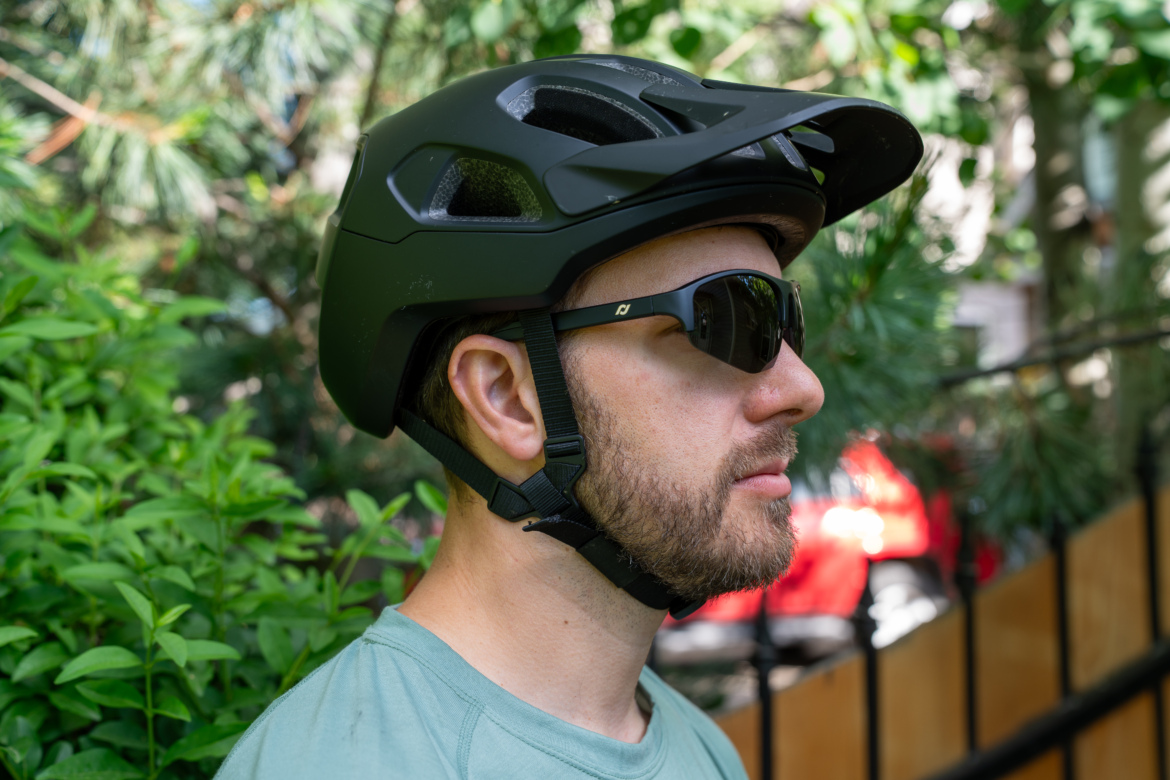
Journey Optics Aliso
- MSRP: $119
- Weight: 28g
- Tester: Greg Heil
Journey Optics designs low-bridge sunglasses “to ensure they stay on your nose and off your cheeks.” The Aliso model features a TR980 Grilamid material, which allows the frame to flex and bounce back into shape, promising long-term durability.
During testing, I found the Aliso fit to be quite narrow. It appears the arms of the glasses are designed to bend outward from the lenses, thereby gripping your head with the entire arm. Personally, I found the sensation to be a bit uncomfortable, although it admittedly proved to keep the glasses in place while riding.
In addition, while Journey bills the G15 lens as “high contrast,” I didn’t find it to offer appreciably more contrast than other lenses tested in 2025. The G15 sports a gray/green tint and does a good job of blocking light in a direct sunlight environment, but when the trail gets even a little bit shady (ie, partial sunlight), the lenses quickly proved to be too dark.
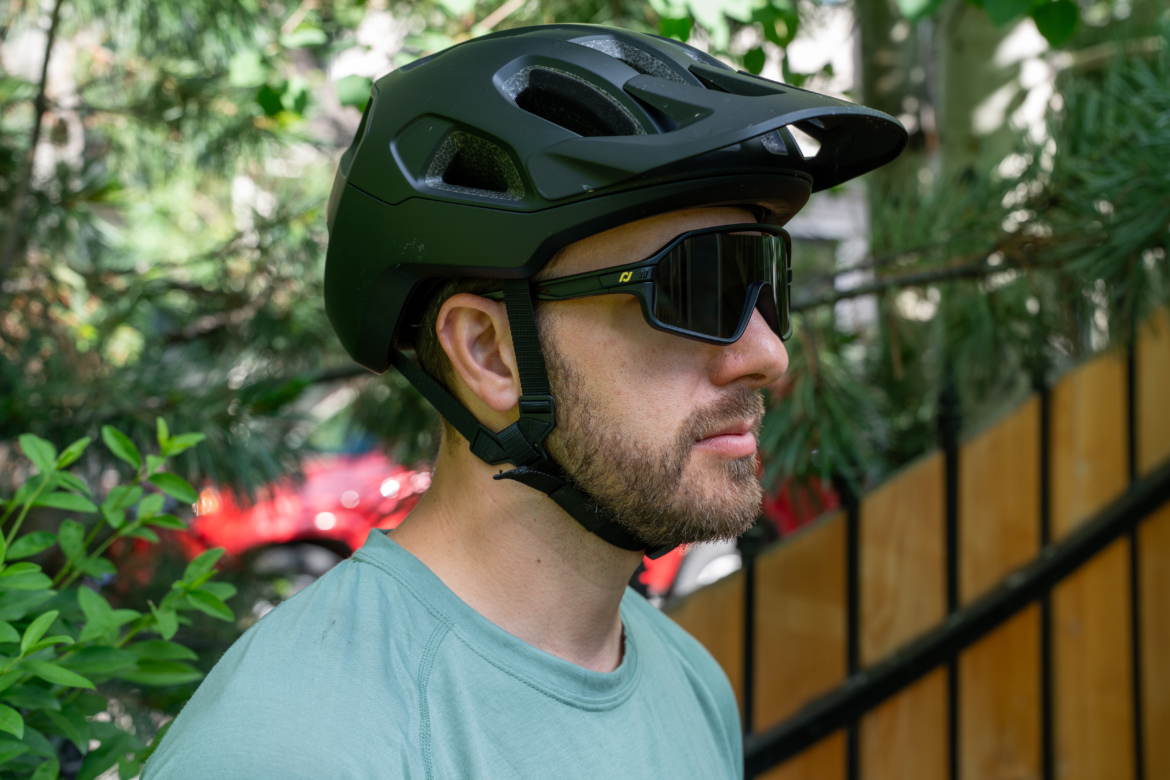
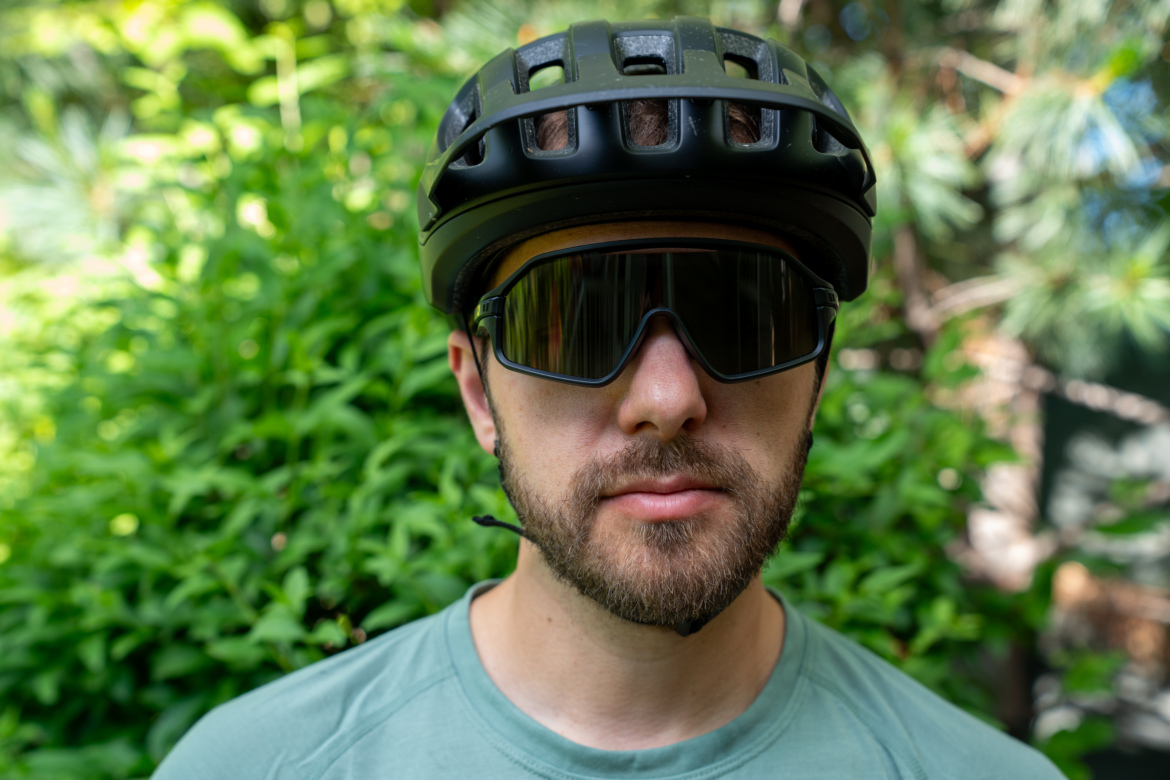
Journey Optics Bommer
- MSRP: $125
- Weight: 34g
- Tester: Greg Heil
Journey Optics designs low-bridge sunglasses “to ensure they stay on your nose and off your cheeks.” The Bommer is the brand’s shield design, which features a flexible TR980 Grilamid material for the frame and a high-contrast G15 lens.
As you can see from a straight-on view of the glasses, the corners (especially both upper corners) are cut off for styling reasons, but I found this styling choice allows substantial sunlight to circumvent the glasses. Thus, even though the Bommer is a shield design, it offers much less light protection than other shield glasses tested in 2025. Despite the cut off corners, I found the glasses to be so tall that they would sometimes hit the brim of my helmet. The Bommer also shipped with a clear lens and was the heaviest pair of glasses tested in 2025.


Julbo Edge sunglasses
- Price: $260
- Buy from Backcountry and evo.
- Tester: Matt Miller
Initially, I thought these were clear riding glasses. That is, until I got into the sun. Almost perfectly clear in low light, the Julbo Edge sunglasses offer good coverage without any blind spots thanks to a mostly wraparound design. Julbo says their REACTIV lens tech offers “the widest photochromic range and fastest reaction time on the market,” and in full sun the Edge sunglasses take on a surprisingly dark amber tint that almost appears reflective on the outside.
The single-piece lens snaps into place using strong magnets at the bridge. It’s one of the easiest systems I’ve tried, and ensures you don’t get greasy fingerprints on the lens. Since the lens is only attached at the center, it floats outside the frame and can get a little clacky on the roughest trails. The nose pads are adjustable for a secure fit to most faces.
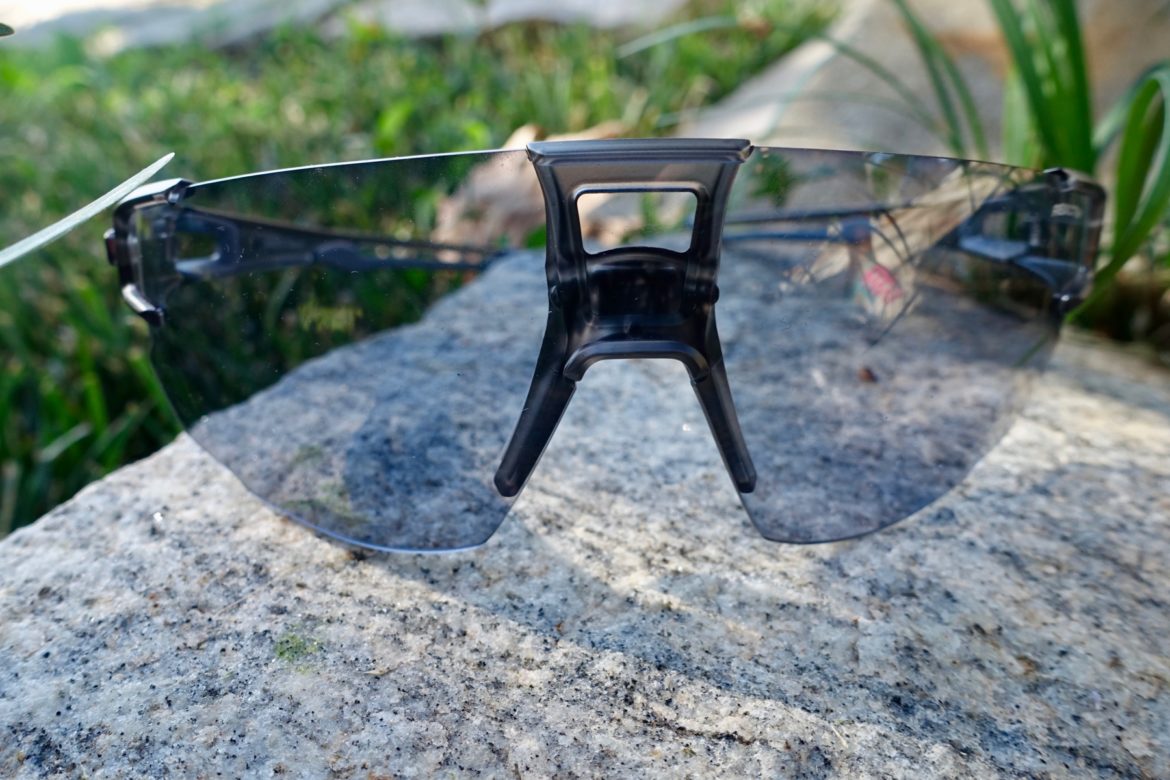

The Julbo Aerospeed sunglasses are comfortable thanks to the flexible nose pads and rubber-like temple tips. The tips allow the temples to sorta float above the ear and the material does a good job holding the glasses in place. At just 27g (actual), the Aerospeeds almost feel weightless.


POC Crave
- Price: $265
- Available at POC Sports
- Tester: Gerow
In keeping with the other shades we tested, the POC Crave MTB sunglasses tip the balance at a meager 29 grams. The ample frames hug the sides of the head well, and POC’s hydrophilic rubber nose gripper keeps them in place even when sweat is working to slide them free. The interchangeable lenses work well in bright sunlight and are a bit darker than I would like for forested riding.
The large lenses of the POC Craves provide impressive coverage to keep your eyes clear and clean. The frames are designed with “snap-in hinges” to allow them to come apart on impact rather than breaking. I find this feature frustrating, as the frames come apart if I simply take the glasses off too quickly. For less ham-fisted riders this shouldn’t be an issue.


POC Devour
- Price: $250
- Available from POC Sports and other retailers
- Tester: Gerow
The POC Devour mountain bike sunglasses offer the broadest eyeball protection of any non-goggles I’ve seen, and they integrate nicely with the larger helmet shell for a clean look. They’re essentially a goggle-lens clamped to a frame, and apart from the dust that blows in the side door, they’ll protect your eyes just as well as a strapped-on shield.
The temples are fully adjustable, and while the lens will look huge on people with smaller faces, they’ll fit a wide variety of head shapes and sizes. The lenses appear super dark from the front—thanks to the mirrored face that obscures your eyes—but from the wearer’s side the tint is light enough to ride on a bright day. In overcast conditions I’ve found them too dark in the shade, though interchangeable lenses with less tint are available.
The lens gets loads of fancy treatments, including what POC calls “Ri-Pel hydrophobic and oleophobic treatment to protect from dirt, water, sweat, salt, oil, and dust,” plus an anti-scratch coating and full UVA/UVB protection. When I first saw the Devours I assumed they’d be far too heavy, sliding all over the place on rough descents. Instead, they sit securely on my 61 cm melon, and the soft rubber at the nose and ears can be bent to cinch them in place.
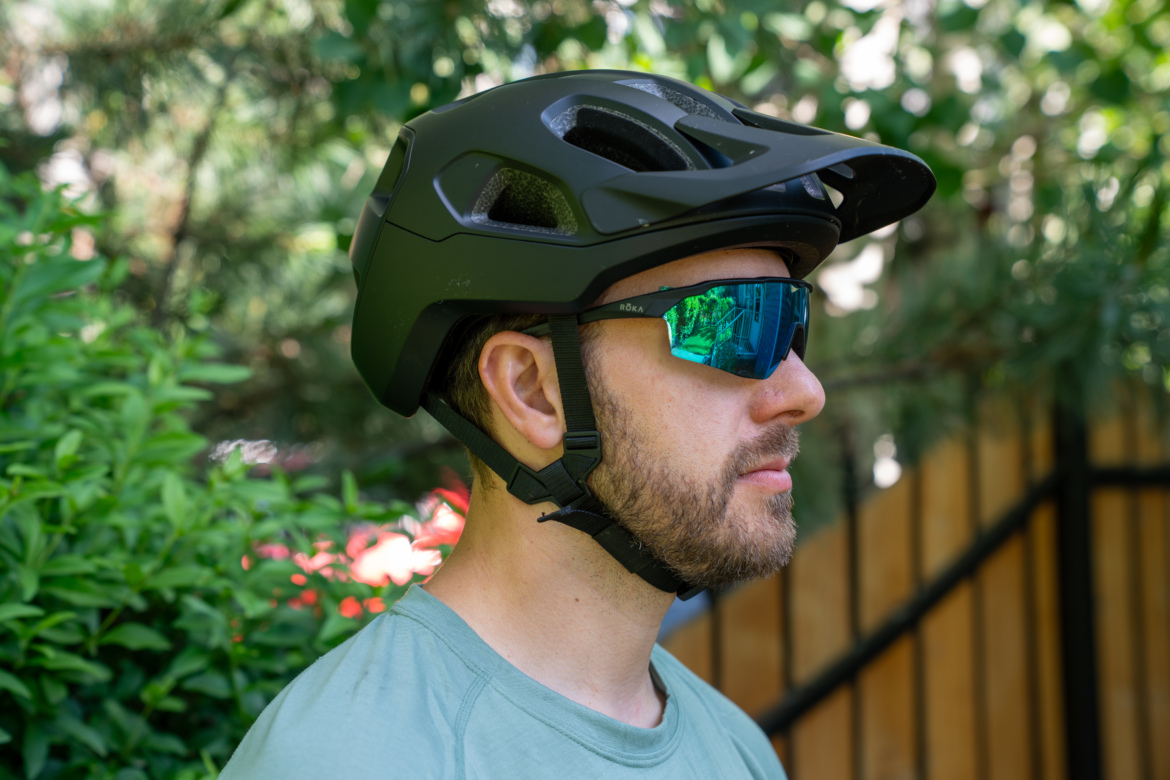
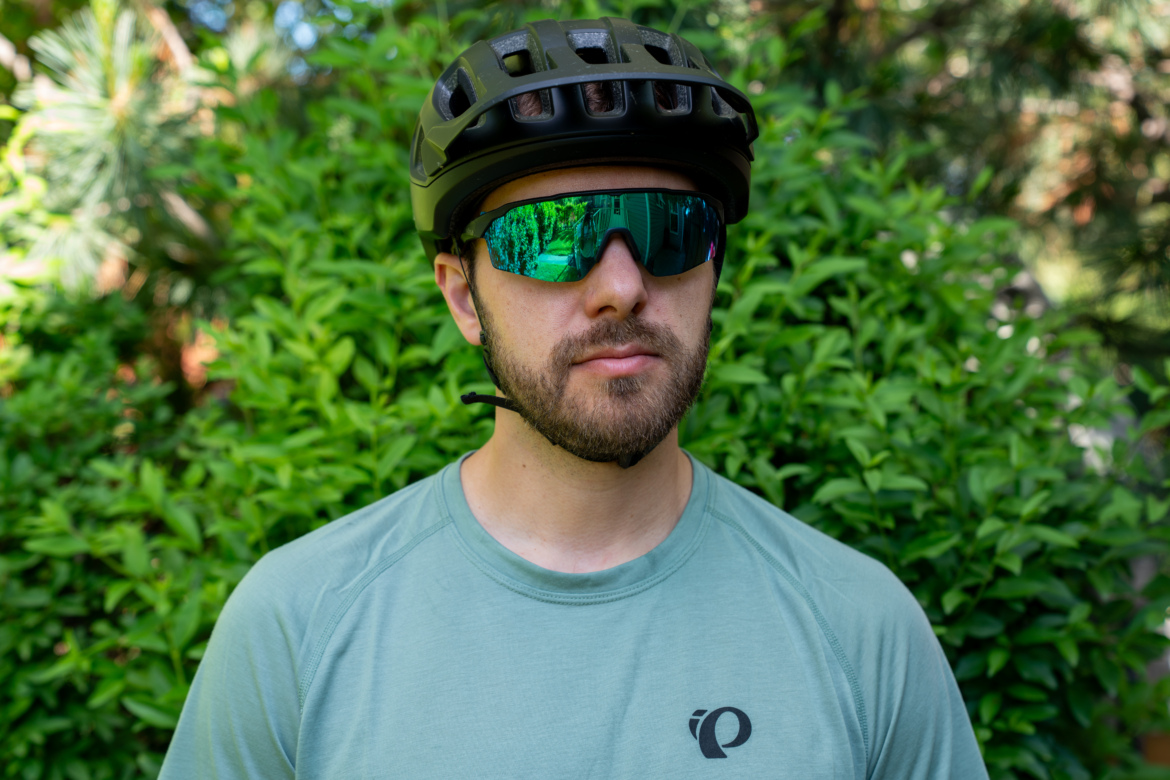
Roka SR-1x
- MSRP: $210
- Weight: 25g
- Buy from Roka
- Tester: Greg Heil
From the minute I donned the Roka SR-1x, the sports-specific frame showed why Roka has made a name as one of the best eyewear brands for athletes. The rubber grippers on the arms, coupled with the rubber nose piece, kept the SR-1x glued in place even through the roughest of rock gardens.
The high-contrast shield lens provides ample coverage and plenty of definition while on-trail. I wore the SR-1x primarily in full-sun conditions in Colorado and found this to be the perfect environment for these glasses.
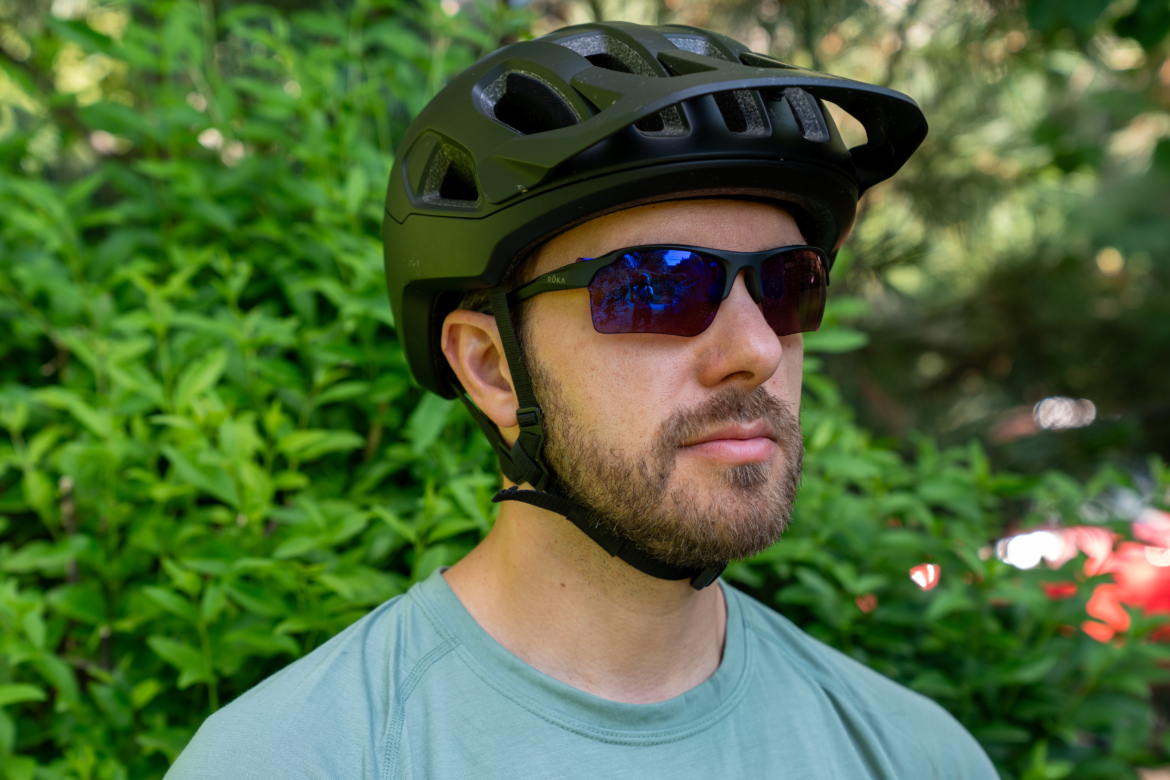
Roka TL-1
- MSRP: $210
- Weight: 21g
- Buy from Roka
- Tester: Greg Heil
While the Roka TL-1 lenses provide great definition in the harsh sunlight conditions found in Colorado, the TL-1 doesn’t provide the same level of peripheral vision as the Roka SR-1x shield-style glasses (or other shield glasses in this test). However, the TL-1 reigns as the lightest pair of glasses tested in 2025 at just 21g. If weight is a major consideration, then the TL-1 should be your choice.
Rudy Project Spinshield
- Price: $164.99 – $219.99.
- Available from Rudy Project.
- Tester: Chris Scheiffer
I took the Rudy Project Spinshield out for a few rides myself and decided they’re just a tad too big for my noggin. To aid in “my” review of these sunglasses, I had my 10-year-old son, who has a much larger head/face, wear them and report back. Here are his thoughts (slightly edited) on the style, fit, and performance of the Rudy Project Spinshield Sunglasses.
“The style seems pretty modern (clearly he was born in 2011). I love the larger size and hot pink color. The Spinshield provides a lot of face coverage and the lens delivers unobstructed, crystal clear vision while keeping dust and debris out of my eyeballs. They’re easy to clean and look cool, which makes people compliment me on the trails. The nose bridge is big enough to fit wide(r) noses and the rubber bridge material seems to get stickier when wet, so the glasses to stay put even on the bumpiest of rides. The arms are thin, lightweight, and fit under all helmets comfortably. It would be nice if the arms had the ability to bend a bit and mold more precisely around a particular head shape, but that’s not the end of the world. Overall, I really like the Spinshield sunglasses, my friends are jealous because I look so good on the trails.”
Pink FLUO with multilaser orange lenses, pictured right. Black Matte with Impactx Photochromatic 2 black lenses, pictured left.
Scott Pro Shield Sunglasses
- Price: $109.99. Pictured: mineral blue / green chrome.
- Available from Scott Sports
- Tester: Chris Scheiffer
The Scott Pro Shield sunglasses are geared toward medium/large faces and are meant to provide maximal field of vision through extra large lenses. The Pro Shield is lightweight (36g) and the frame is made from 45% bio-based polymers sourced from castor beans. You read that right; beans. On top of attempting to minimize their carbon footprint, Scott has also applied a fair amount of technology including: interchangeable lenses, no-slip nose and temple pieces, impact protection, optimized helmet integration, 100% UVA/UVB protection, and ACS (Air Control System) ventilation.
The silicon nose piece is said to be no-slip, but I found it did slip down my nose when bombing down chatter and when sweating heavily. Fortunately, the rubberized temple pieces hold nicely in place underneath my helmet adjusters. One feature I really like is the ACS (Air Control System) which refers to the almost unnoticeable cutaway vents on the top left and right of the brow.
Overall the Scott Pro Shield sunglasses are comfortable on their own, and with most helmets. I tried these on with all of my helmets (six to be exact) and I can confidently say they fit nicely with most of them. Though the rubber nose piece isn’t as grippy as I’d prefer; the style, weight, and lens quality is top notch.
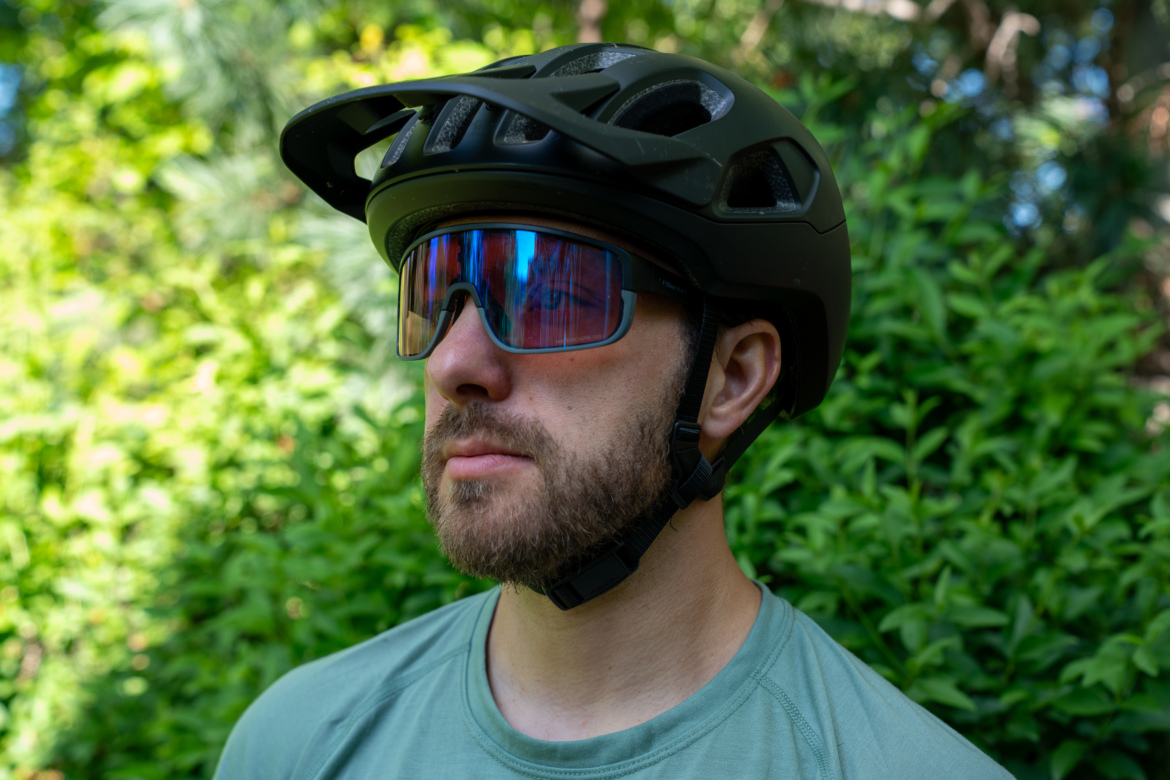
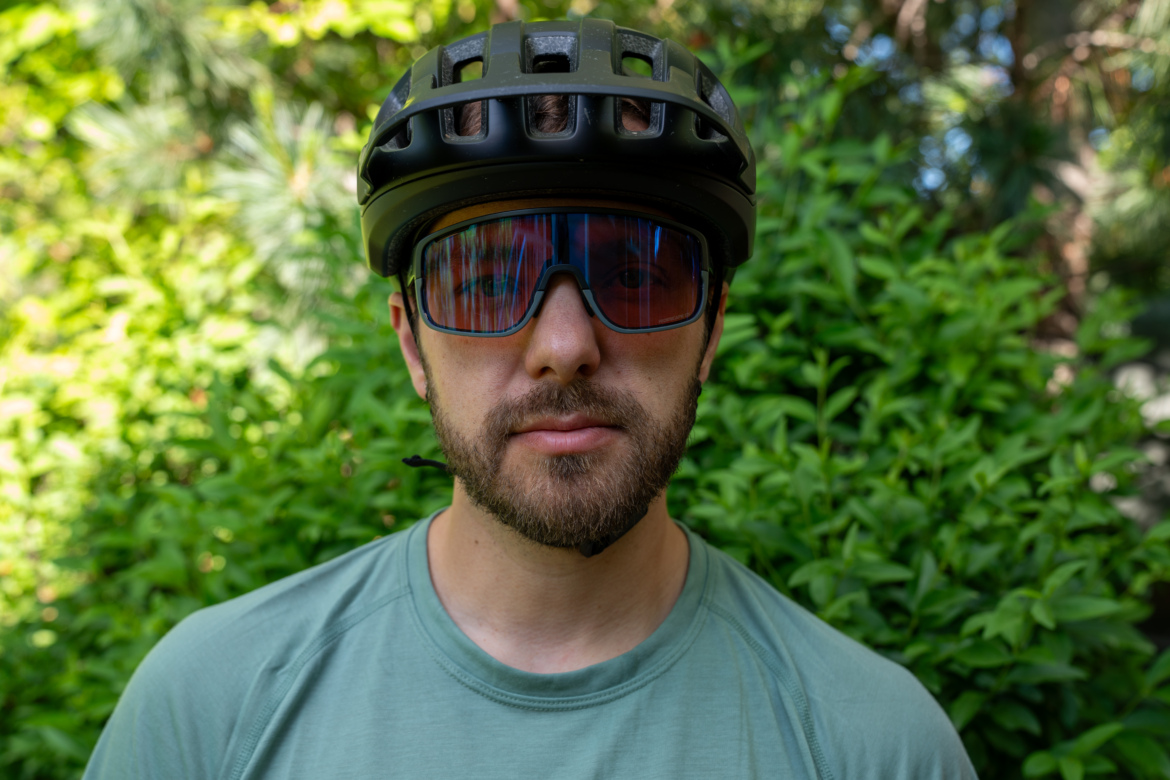
Shimano Ridescape Pulsar CE-PLSR3
- MSRP: $100
- Weight: 31g
- Buy from Performance Bike
- Tester: Greg Heil
The new Shimano Ridescape Pulsar CE-PLSR3 is designed around versatility. The standard lenses can be swapped with included clear lenses, and the bottom half of the frame can be removed to change up the aesthetics.
I found the Pulsar CE-PLSR3 to offer ample coverage and a robust form factor. I used the included lenses in relatively low-light conditions in the deep forests in Arkansas, and rarely found myself needing to switch to clear lenses.
While you can’t see the connector in the center of the glasses that connect to the nose piece while wearing them, it looks too awkward to wear these glasses in casual situations. Also, depending on the helmet you’re wearing, the relatively tall lens plus frame combo may impact the helmet.

Smith Bobcat Sunglasses
- Price: $209 – $229
- Available: Smith Optics.
- Tester: Leah Barber
That “so enduro” look doesn’t always work for smaller faces, and the Smith Bobcat is the smaller fun-duro version of the popular, goggle-like, enduro-sized Wildcat glasses. Now we can be in the cool kids club without glasses slipping off the ends of our noses! Seriously though, the Chromapop optics make everything clear and vibrant. There are also some new classy colors (navy, merlot, gold) to coordinate with their helmets.

Smith Momentum Sunglasses
- Price: $230
- Buy from Smith Optics.
- Tester: Matt Miller
The Smith Momentum is another great quasi-goggle for those with smaller faces and don’t want to be engulfed with their shades. The Momentums feel stable and secure under any movement or shaking. The two-position nose piece is easy to adjust although changing lenses is more involved.
Fortunately, you don’t have to do that often with the photochromic lenses. They transition surprisingly quickly from tinted to clear and vice versa. The photochromic lens isn’t as dark as other dedicated dark lenses but they still have good protection and keep a natural color to them when peering out.


Smith Shift Split Mag
- Price: $289
- Buy from Smith Optics.
- Tester: Matt Miller
The Smith Shift Split Mags are another favorite in the roundup. They come in about two handfuls of different color options, have Smith’s ChromaPop contrast/color-enhancing technology, photochromic lenses, smudge and moisture-resistant coatings, and grippy nose pads and temples.
These have a flatter fit than the Momentums and fit very lightly on the face, but have been stable. The ChromaPop might sound like snake oil, but it produces a distinct difference in color and contrast, and makes for some very vibrant greens. One of the nicest features on the Shift Split Mags is how easily and quickly you can swap the lenses. The temples essentially pinch off and so does the nose piece, before mounting to the other lens.


Sweet Protection Ronin Polarized
- MSRP: $200
- Available at Moosejaw
Sweet Protection continues to drop quality mountain bike apparel and protection. The Ronins compliment their line well, and have become a favorite. They have a technical look, but easily fit in on casual rides.
They have an anti-fog inner lense and a Super Oleophobic and hydrophobic coating which helps water roll off the lens, as to not become problematic for vision.
This technology seems to work pretty well, although it doesn’t stop sweat from gunking up the inside of the lens. If you’re OK with wiping the inside down occasionally, since the lens sits very close to the forehead, they’re a great option. I didn’t have any issues with the glasses sliding down. They vent well, although not the best out of the entire group.
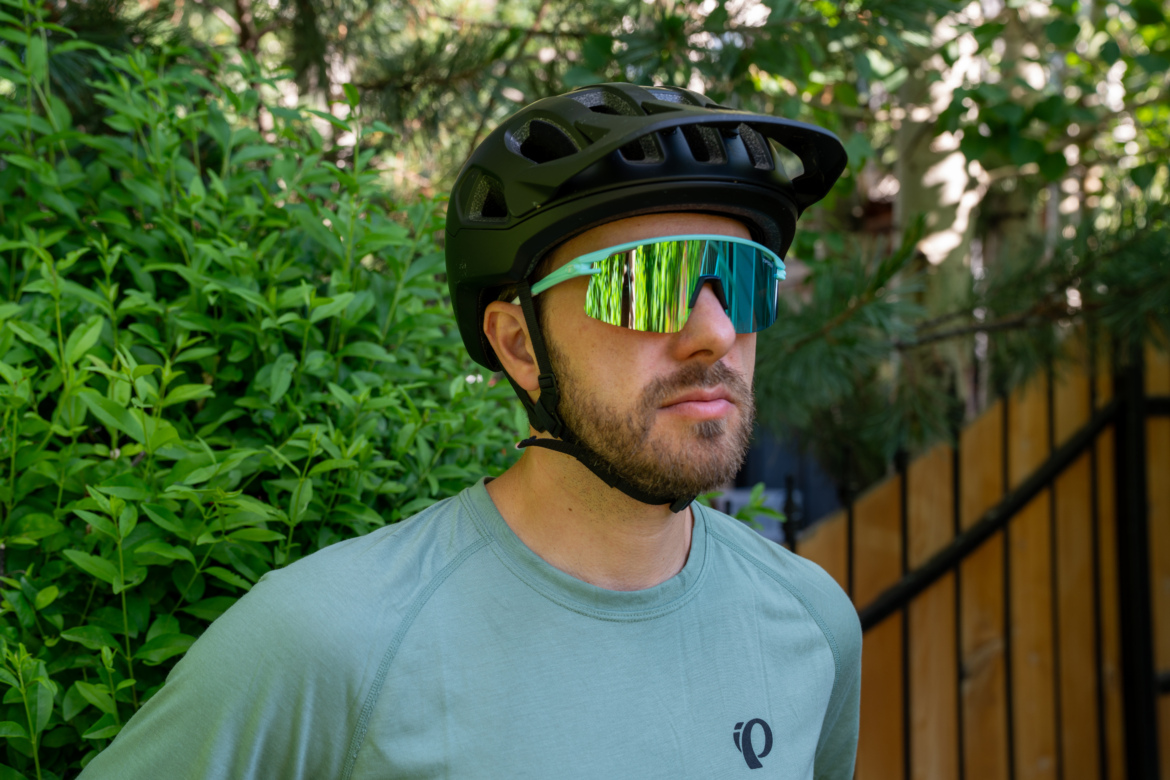
Tifosi Moab Lite
- MSRP: $79.95
- Weight: 28g
- Buy from Amazon
- Tester: Greg Heil
Tifosi took its tried and true Moab glasses and slimmed down the frame to this minimalist shield design. The Moab features a distinct rectangular profile for both the lens and the frame, which is distinct from the other glasses tested in 2025. The rectangular design provides ample coverage.
The standard scratch-resistant and shatterproof polycarbonate lens provides great definition in direct sunlight environments. Plus, the $80 Moab Lite ships with not one, but three lenses to choose from. For mixed light conditions, a second lens provides some sun blocking while simultaneously increasing trail definition. And finally, the third lens is clear for low-light conditions. With three lenses for under $80, the Moab Lite might just offer the best value of all glasses tested in 2025.

Tifosi Rail XC
- Price: $80
- Buy from Jenson USA
- Tester: Matt Miller
The Tifosi Rail XCs are one of the more affordable glasses in the group. They are made with a smaller and lighter design than the Rails and do away with a frame to maximize the field of vision and are marketed for either cycling or baseball. Tifosi says the lenses have 100% UVA/UA protection, a light and durable Grilamid frame, adjustable nose and temples, and a small to medium fit. The glasses include three lenses in total.
The Rail XCs have a light fit. Though Tifosi says the Rail XCs are on the smaller side of fit, the temples spread open quite a bit. They fit well and have good coverage, and swapping lenses is simple and quick enough. My only complaint with the Rail XCs is that they have fogged up on me pretty quickly after coming to a stop on cooler, more humid days.


Tifosi Sledge
- MSRP: $79.95
- Available from REI
- Tester: Gerow
Tifosi is an Italian word that translates to “supporters,” and the Sledge glasses live up to that name with massive windshield coverage and a forgettably comfortable fit. The lens is vented across the top, and the frame sits far enough from your skin that they don’t fog up quickly, making them ideal for long rides.
All three included lenses offer distinct tints—two excel on darker trails under thick canopy—and the one-piece frame means there are no small bits to drop or lose when changing lenses. Considering their price, comfort, features, and overall protection, these are some of the best riding glasses I’ve tested to date. The kit even comes with a microfiber cleaning cloth and clamshell case for easy storage and care.
We also tested the Tifosi Sledge Lite, which, despite its “Lite” moniker, still has a presence. By subtracting the bottom portion of the frame, Tifosi “packs all the performance of Sledge into a streamlined, lighter design,” while retaining adjustable temples and nose piece, a durable Grilamid frame, and swappable lenses. With four vents along the top and side vents where temples meet the lens, airflow is ample to keep sweat from building around the eyes, and they’ve held up scratch-free all season. The Sledge Lite is recommended for medium to extra-large faces.
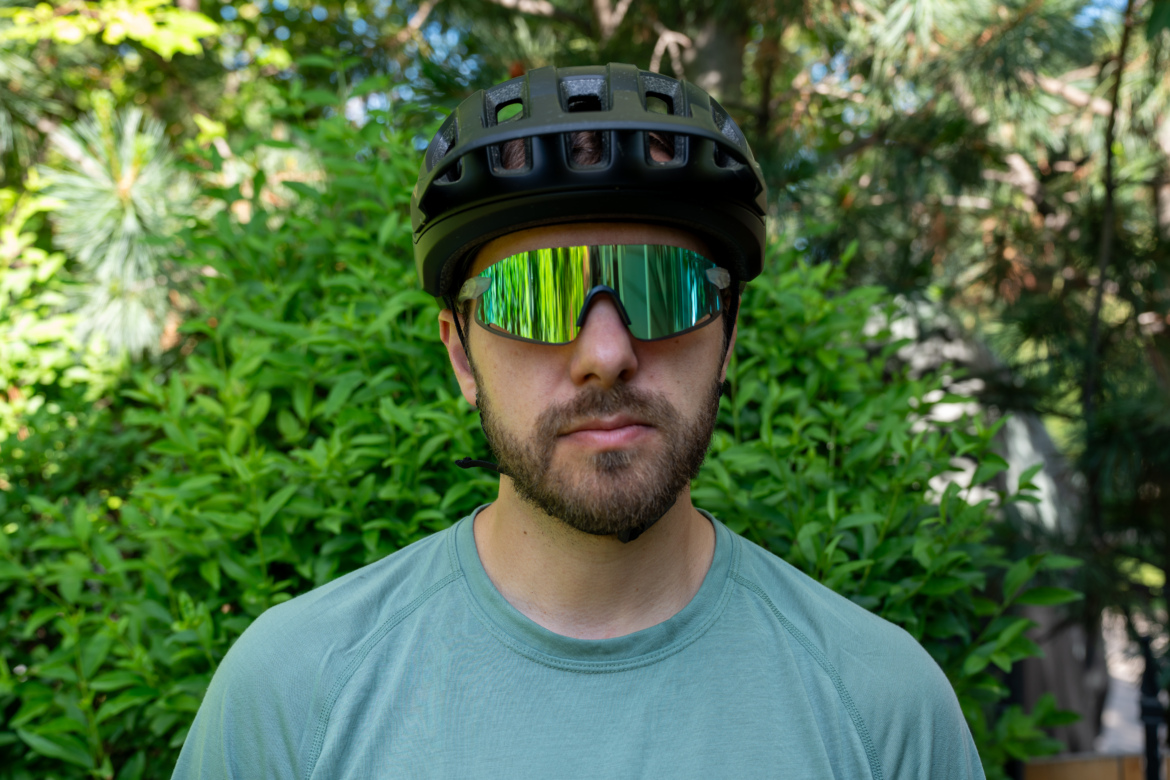
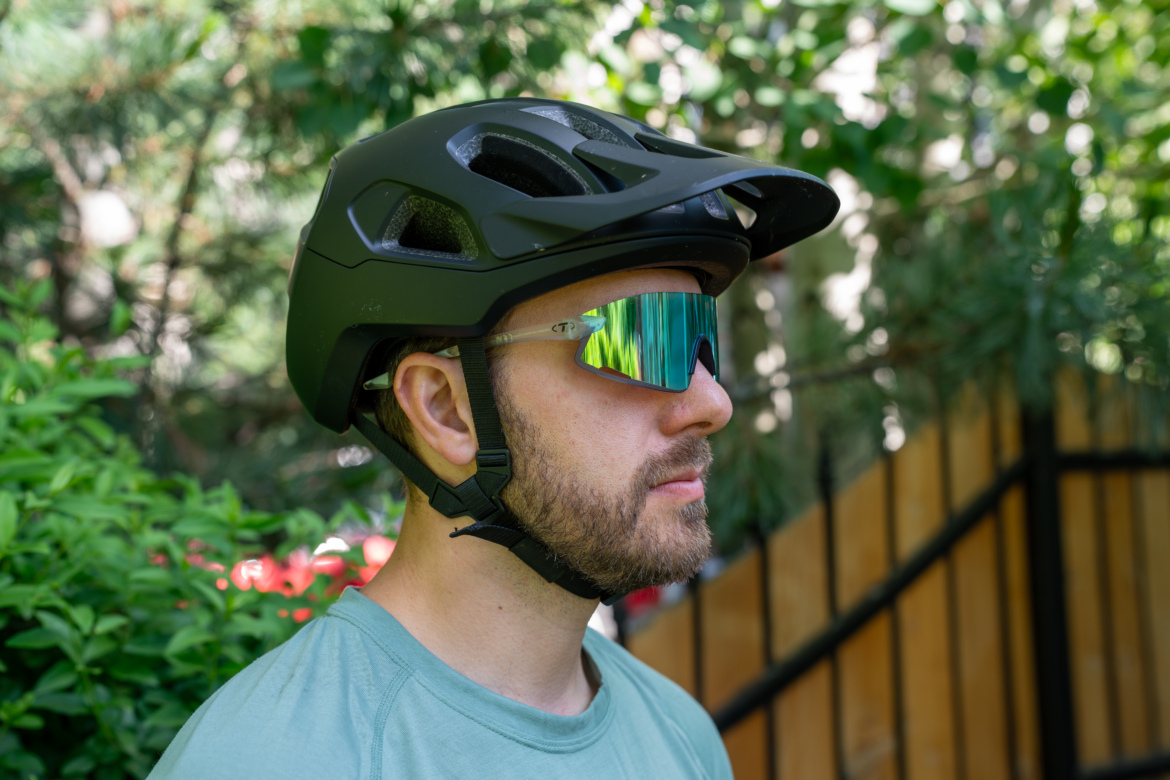
Tifosi Vogel XC
- MSRP: $40
- Weight: 24g
- Buy from Sun & Ski Sports
- Tester: Greg Heil
Shield sunglasses can be too big for some riders’ faces. If your shield is too big, it can hit on the helmet, making for an uncomfortable fit. Enter the Vogel XC. The Vogel XC intentionally offers a slimmed-down shield design, which is ideal for smaller faces and for those who want a lightweight pair of glasses.
I enjoyed the feather weight and form factor of the Vogel XC, but I felt like the fit left something to be desired. Compared to similar shield glasses from Roka, the arms and nose piece on the Vogel didn’t feel nearly as confidence-inspiring. Even so, Tifosi offers the best value glasses in this test, and the Vogel XC was the most affordable pair tested in 2025.
Mountain Bike Lifestyle Sunglasses
Having some eye protection while mountain biking is arguably essential, though you don’t always need a separate pair of sunglasses for on and off the bike. Most of these lifestyle mountain bike sunglasses are designed for everyday use by active individuals, making them great for multiple sports and life in general.


Blenders Eyewear
- Price: $49.
- Available from Blenders.
The Natty Ice Lime (right) and Royal Blitz (left) sunglasses from Blenders Eyewear both utilize the same “M Class X2” design but clearly offer different personalities. These aren’t bike-specific or performance-oriented glasses, weighing 30g and offering little-to-no wraparound. The temples and arms aren’t adjustable, and there’s no rubberized anything anywhere. Still, I’ve found they do just fine protecting from rays and slappy branches on the trail, and fit in just fine with my bike helmet.
I had a hard time choosing between the Natty Ice Lime and Royal Blitz glasses, so I ordered both. Each is available with polarized lenses for maximum ray blocking abilities, while the Royal Blitz adds a unique twist by fading from purple to yellow top to bottom. The effect is noticeable inside the glasses as well with the purple working to enhance contrast and the yellow to diffuse blue light on hazy morning starts. If I had to choose a personal favorite between the two styles, I would go with the Natty Ice Limes.


Bollé Brecken
- Price: $90 – $110
- Available at Bollé
The stylish Brecken frames from Bollé weigh in at a cool 29 grams, and that light weight helps to keep them from slipping off your face. The Brecken frames include a standard or polarized set of lenses (shown), and can be ordered with prescription lenses upon request. Bollé says they gave the lenses an anti-reflective treatment, hydrophobic treatment, and oleophobic treatment. That’s a lot of tech for one pair of shades.
I have a large head, and wide face and the Brecken frames fit quite well. Their temples squeeze my head just enough to keep the glasses from rattling around on my nose. The shape does allow more air, and possibly dust, in from the sides, but this might be a sacrifice some folks are willing to make to have a less performance-oriented aesthetic. The polarized lenses are a bit too dark for some sections of trail, limiting vision when the sun’s rays are blocked. For rides in moderate to direct sunlight, the Brecken shades are a good looking option.

Glade Townie Sunglasses
- Price: $99
- Available from Glade.
The Glade Townies are glasses for people who don’t like mountain bike glasses. They have a classic square wayfarer shape with rubber under the nose and at the end of the temples. The Townies come in five different colors, have polarized lenses, a partially bio-based Grilamid frame, and they do a great job at reducing bright glare.
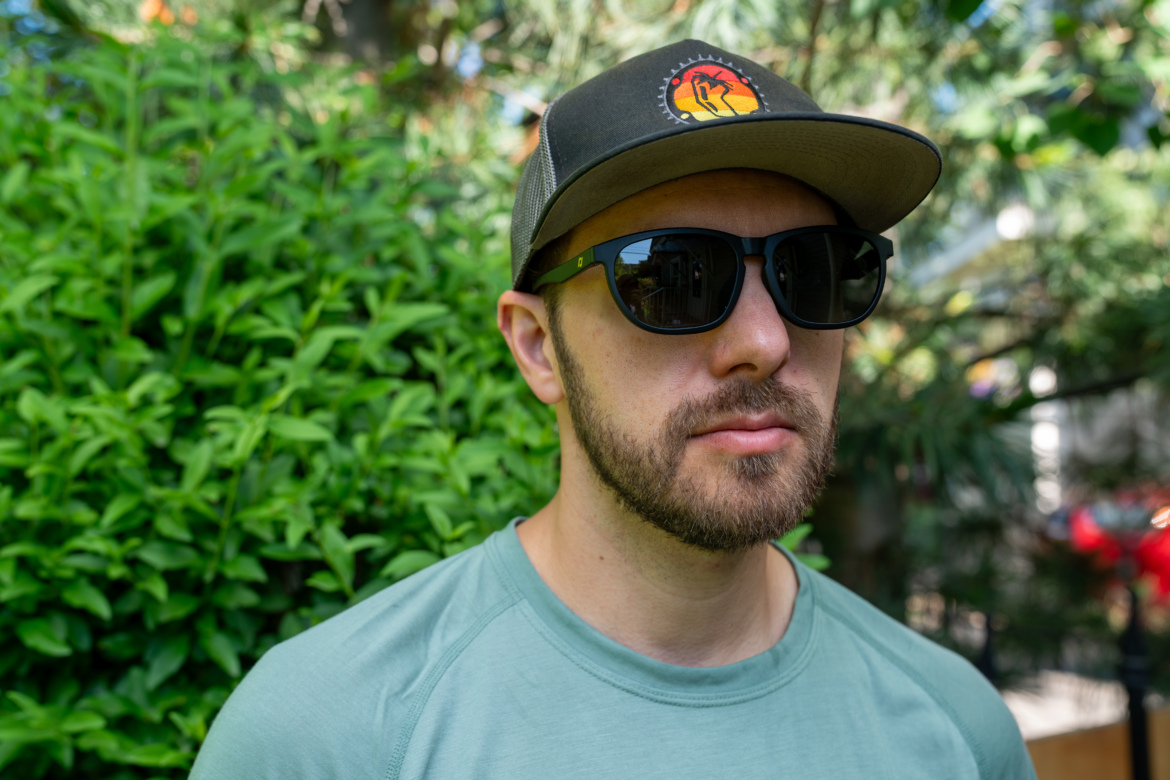
Journey Optics Pismo
- MSRP: $95
- Weight: 24g
- Tester: Greg Heil
Journey Optics designs low-bridge sunglasses “to ensure they stay on your nose and off your cheeks.” The Pismo glasses are one of their lifestyle offerings that are at home on the street or at a wedding (tested), but can also pull double-duty on the trail in a pinch, thanks to the TR90 Grilamid flexible frame material.
I found the glasses to be comfortable, durable, and stylish during my testing. The flexible frames encourage me to think I’ll be less likely to break these glasses while tossing them into the glove box or forgetting them somewhere in my van. I found the lenses to be very dark and only really usable in direct sunlight.


KOO California Sunglasses
- MSRP: $150
- Available at Amazon and other online retailers.
On the chillin’ side of eye protection, the KOO California sunglasses have what I think of as a classic jazz saxophonist look. The lenses are broad, covering a large portion of my wider-set eye sockets. While the après-ski shape doesn’t lend a great deal of airflow, they are good for faster rides on flowy singletrack or dirt roads.
This pair has a polarized Zeiss lens, which I don’t find ideal for mountain biking as it seems to diminish shiny reflections on wet rocks and roots. Fortunately, the California shades are also available with two different non-polarized lens options, with seventeen different frame colors to choose from.
The California sunglasses include a carrying case to keep them in good shape before or after rides.
Nathan Sunrise polarized glasses
- Price: $60
- Available from Nathan Sports
These glasses from Nathan—aptly named the Sunrise Polarized Running Glasses—aren’t just for runners. Many riders I know, especially greener ones who shy away from a racey, cyborg look, gravitate toward something more casual like these Nathans.
Made from polycarbonate, they offer 100% UV protection and are said to reduce glare. The rubberized temple ends and “soft feel” frame keep them comfortably in place, and they’re prescription-lens compatible. Though the lenses sit a bit wide, they still fit my narrow face well and feel as durable as some of the pricier options. The only minor quibble is the lack of rubber on the nose piece and a slight frame intrusion at the periphery, but it never creates a true blind spot.
Perhaps the best thing about these easy-going athletic glasses is the price tag.


Ombraz Teton Armless Sunglasses
- Price: $145 (non-polarized) – $160 (polarized)
- Available from Ombraz.
Like the OG Ombraz, the new Ombraz Teton sunglasses are armless. Instead of arms, the wraparound nylon cord is adjustable to fit (and stay on!) more heads – yes, even small ones. The squarish lenses on the Tetons are scratch-resistant and available in grey, brown, and yellow. The grey lenses tested provide a good amount of shade, and with the armless design, these darker lenses are better suited for being out on a sunny day when you want to keep your glasses on for long periods of time. The incredibly light aerospace-grade nylon frames (23.9g in total) come in classy tortoise and charcoal styles.
The armless Ombraz Tetons and the more circular Viales aren’t your average sports sunglasses, and they do have a very chic, Euro vibe that’s perfect for all kinds of summer adventures. And with any pair of Ombraz sunglasses purchased, the company plants 20 mangrove trees.

Roka Halsey
- Price: $180 – $205
- Available from Roka
Wouldn’t you know it: the best “looking” glasses on this list are also among the most expensive. No shortcuts here, I found the Roka Halseys offer the clearest, most neutral view while blocking squint-inducing rays. The Halsey sunglasses seem to offer the least amount of darkening, which is great for riding trails that throw up a mix of full sun and full shade.
Roka says the “glacier mirror” lens in the Halseys I tested is a “moderate contrast, neutral-color lens that provides comfort during everyday use in very bright and sunny conditions.” All the lenses and coatings Roka uses are by Carl Zeiss vision, and they’re coated and cut specifically to fit Roka frames.



The clear frames I tried feel solid and substantial, and this is backed up by the fact that these weigh 25.7g, among the heavier sunglasses in this test. The hinges offer a good bit of resistance with virtually zero squeak. Black, rubberized temple tips keep the straight temples in place, though the downside is the temple ends tend to interfere with my helmet retention system a bit more than the others. The rubberized nose pads are not adjustable, but they utilize a clear white material so they blend into the white frame.

Sunski Topeka
- Price: $68
- Available at evo
Sunski believes sunglasses should look good, fit good, be affordable, sustainable, and work well for athletic endeavors. Sunski uses scrap plastic to make the frames. They also don’t use any plastic packaging and the glasses come in a recyclable (and recycled) cardboard packaging.
The Topeka are a Wayfarer-style of sunglasses and keep the sportiness dialed down to a minimum. They’ve turned out to be a great set of glasses on the trails, and work well for smaller faces. The Topeka have a sturdy hinge, and rubberized temples and a rubberized nose. They weigh 21.6g. The lenses are polarized and Sunski can replace lenses if they become too scratched. The only downfall I noticed testing, is that they can be a little dark in dark woods, otherwise they’re a great, affordable pair, and it’s great to see them put sustainability in the forefront of their company.
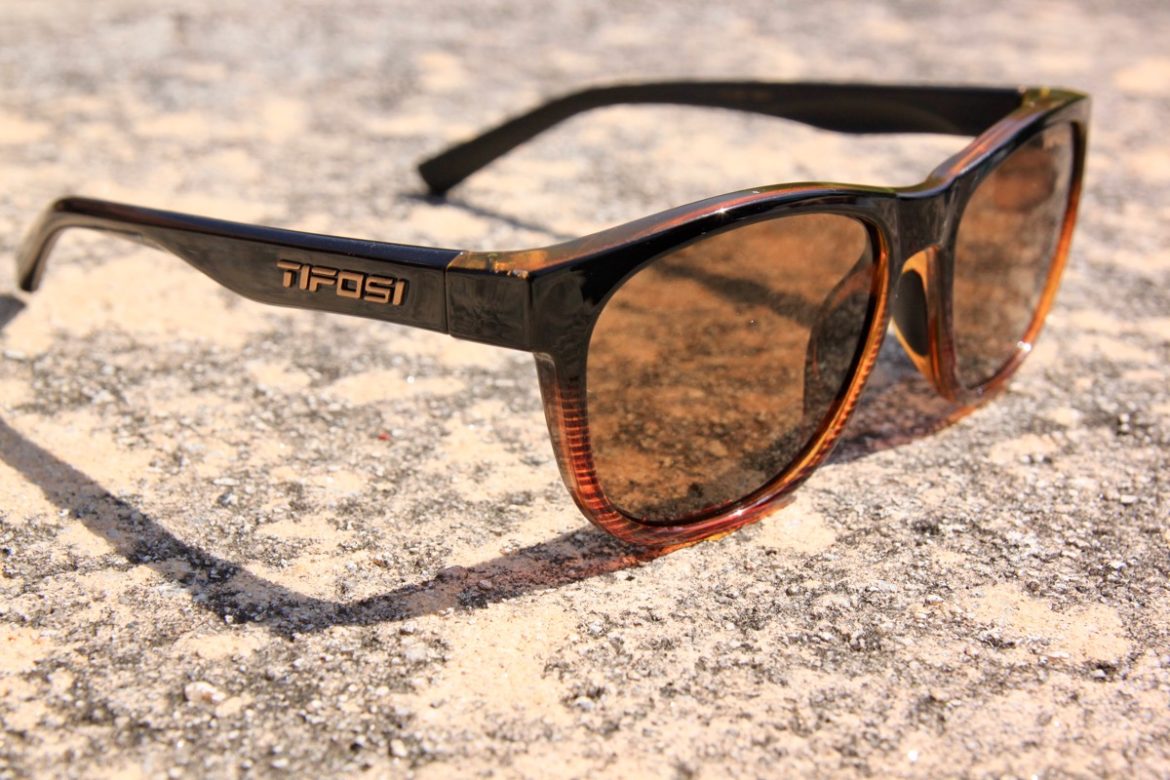
Tifosi Swank
- Price: $25 – $59.95
- Available from Amazon
- Tester: Jeff Barber
The Tifosi Swank sunglasses collection features a classic style at an affordable price: starting at $25 for non-polarized lenses, and $54.95 for polarized. Tifosi blows the others away in terms of color combos, giving buyers the ability to choose from 24 styles plus custom options.
The sunglasses provide adequate sun protection, though obviously not as well as the polarized or reflective lenses on this list.
While the Tifosi Swank sunglasses I tested do not feature rubberized temple tips, they do have padded (though not adjustable) rubberized nose pads. Unfortunately I found the Swanks to feel a bit crooked on my face compared to others in this test. They are also on the tight side, so perhaps better suited to riders with more narrow noggins than mine.

Roka Lola 2.0 Sunglasses
- Price: $220
- Buy from Roka
- Tester: Leah Barber
Many of the Roka sunglasses fit smaller faces well and the Lola 2.0 sunglasses in the new crystal frame collection have just enough color and flair for a fresh and fun look. The frames are incredibly lightweight and like all Roka sunglasses, have the no-slip grippers at the nose and temple tips to help keep the cat-eye frames on your face. The polarized lenses are crystal clear, giving leaves and rocks nice definition. Custom combos are also available with a half dozen lens types.

Tifosi Swick prescription sunglasses
- MSRP: Starts at $100 for prescription glasses; non-prescription starts at $25
- Buy from Amazon.
- Tester: Matt Miller
While it’s natural for many of us to wear prescription glasses at work, reading books, or watching TV, getting a set of prescription specs for riding—our favorite pastime—can often take a backseat to other gear. Prescription sunglasses are expensive and sometimes hard to find. Tifosi makes a lot of good cycling glasses that cost half as much as other premium brands, so when they offered to send some prescription riding glasses, I was excited to try them out. Choosing the right pair proved tricky: most of their prescription offerings lean casual or active, with few styles suited to the demands of cycling. I’d hoped for the Rivets, but my pupil distance was too narrow, so I opted for the Swicks, whose classic square frame isn’t out of place on the trail.
On my first ride, the Swicks took a few minutes to settle on my face, but then I awoke to the vividness of prescription cycling eyewear—everything on the trail came into crisp, high-resolution focus. The frames gripped securely, and I never worried they’d slip, though they do get a little warm and sweaty without venting. I paired them with Fototec light-adjusting lenses, which performed admirably under the dense canopy of darker forests and the bright glare of exposed hills.
Overall, I’ve been happy with the Swicks. They strike a solid balance between everyday wearability and the visual clarity that makes prescription cycling glasses worth the investment—especially at Tifosi’s value price point.


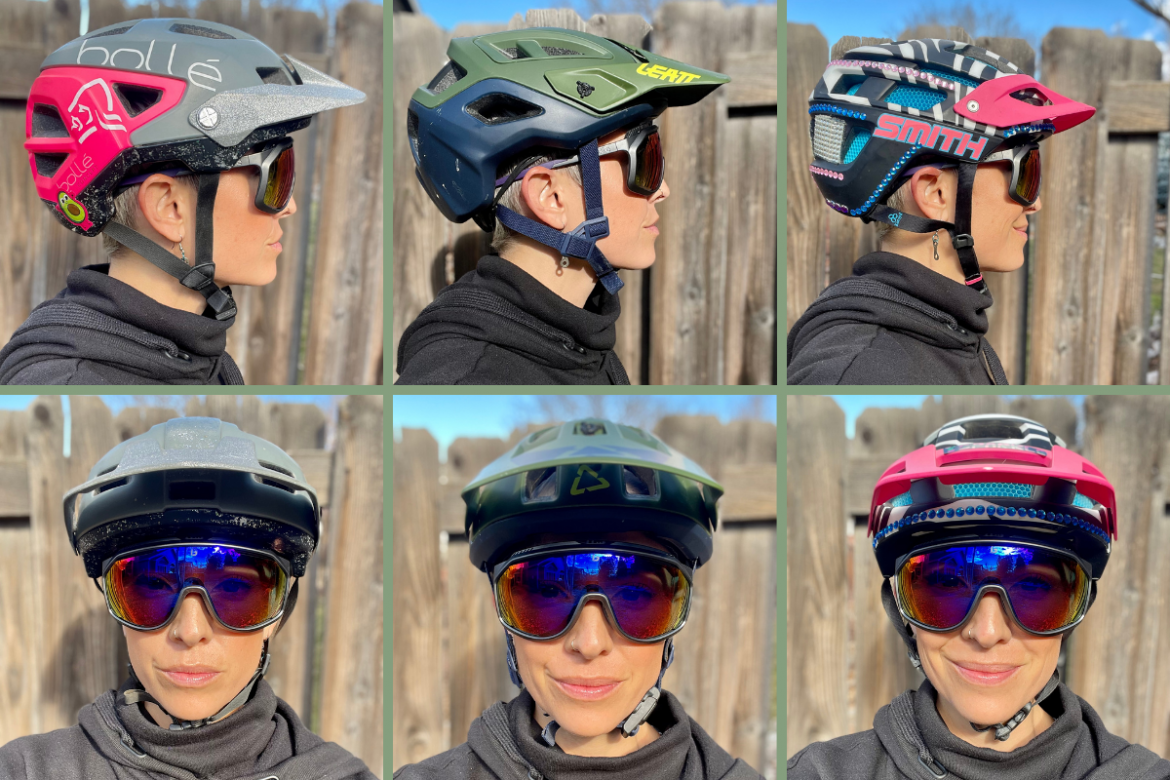

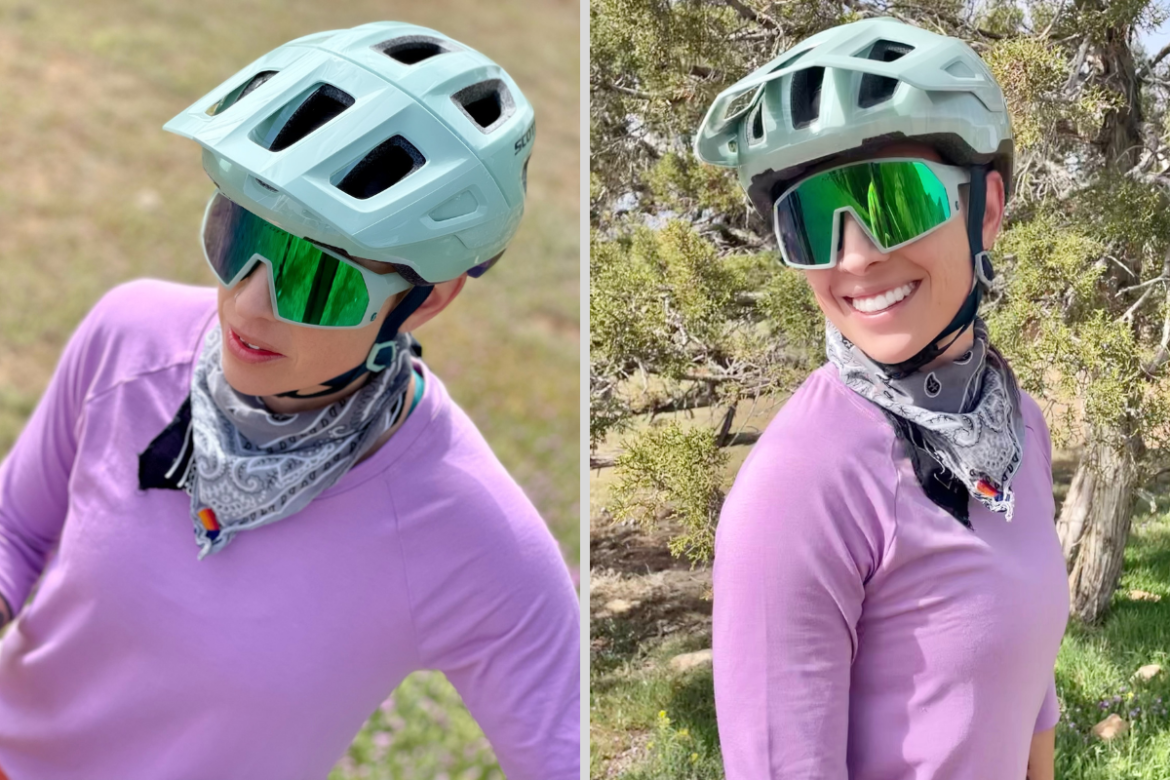
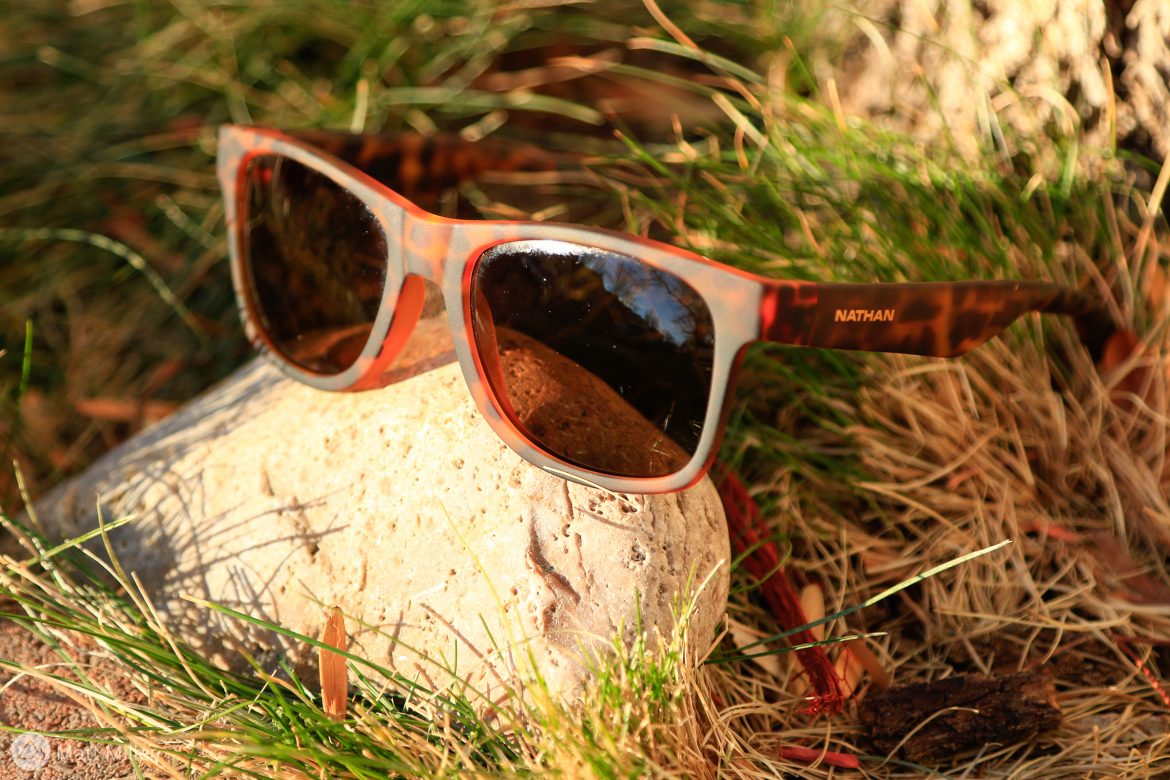




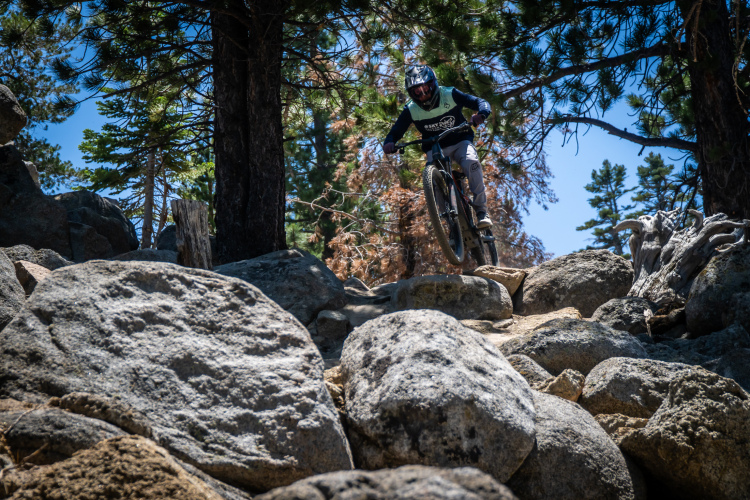

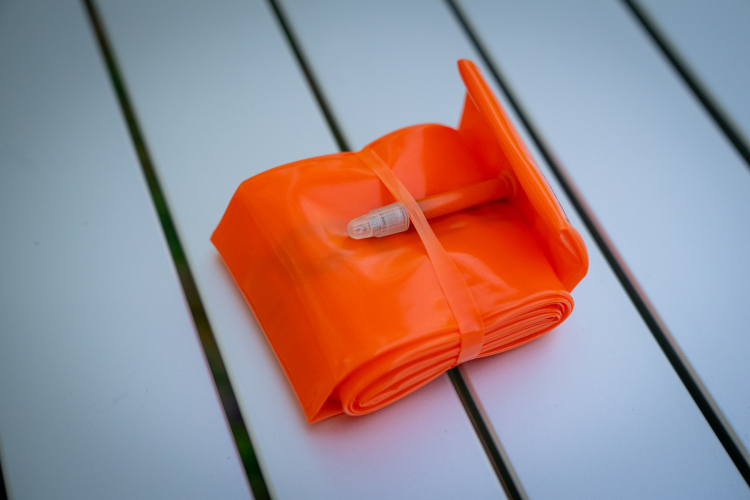
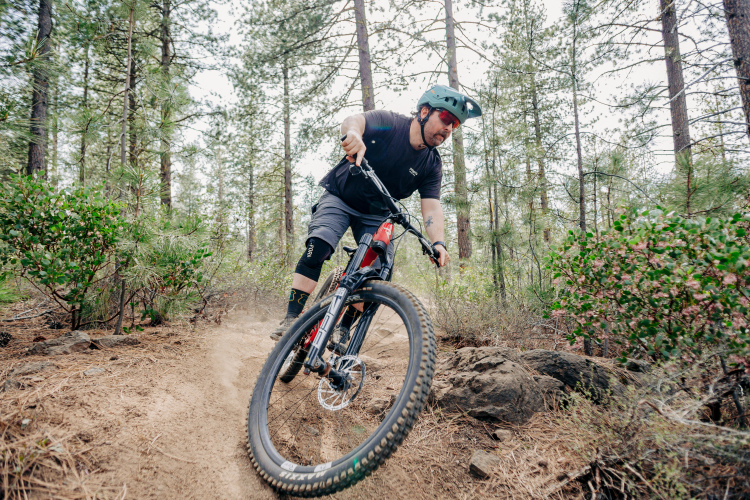

2 Comments
Oct 21, 2022
Jul 8, 2022